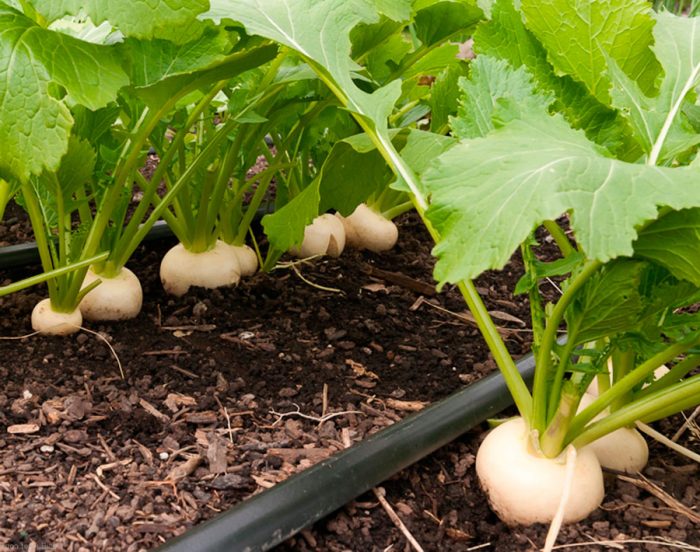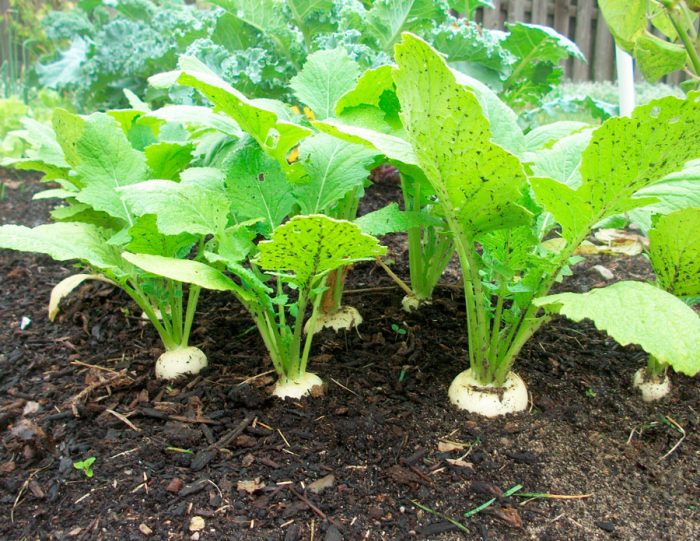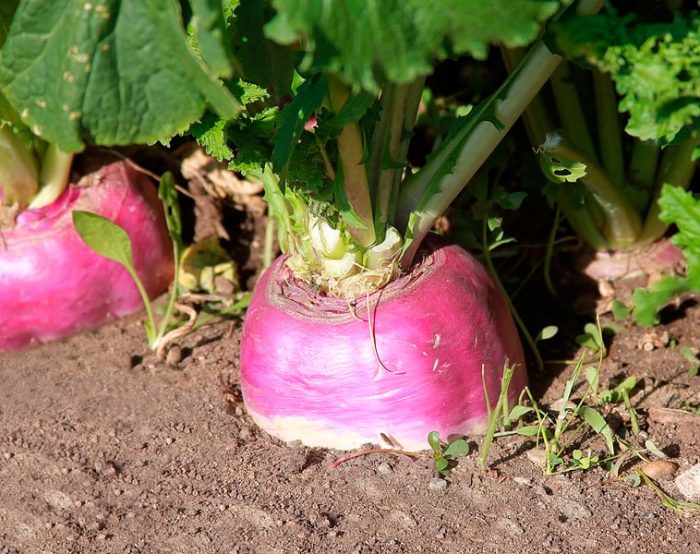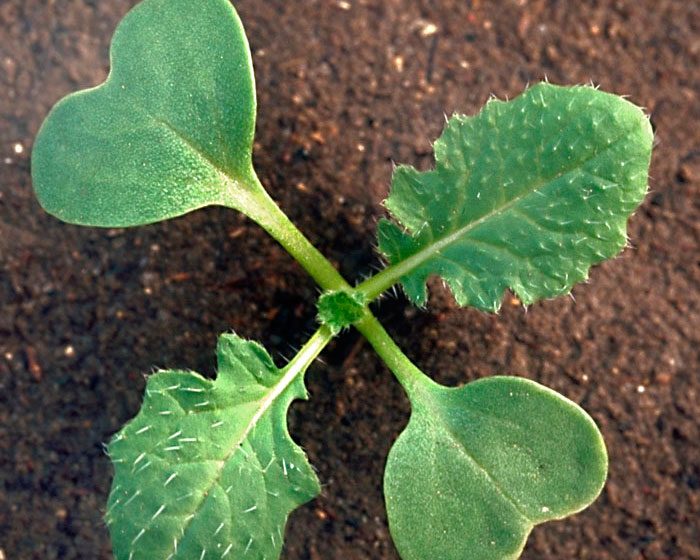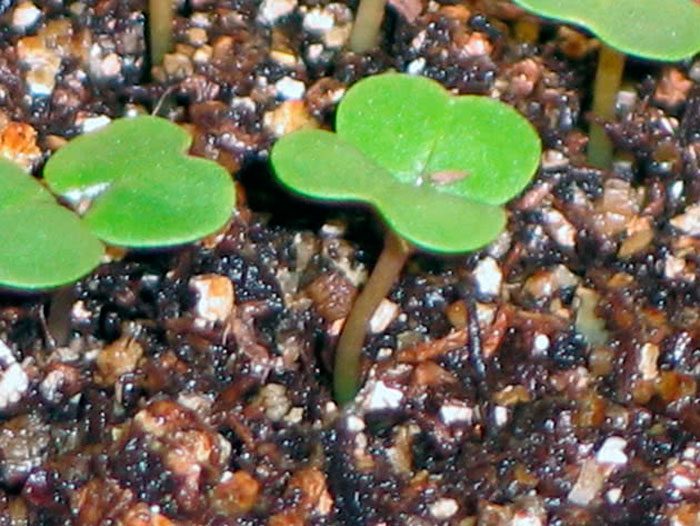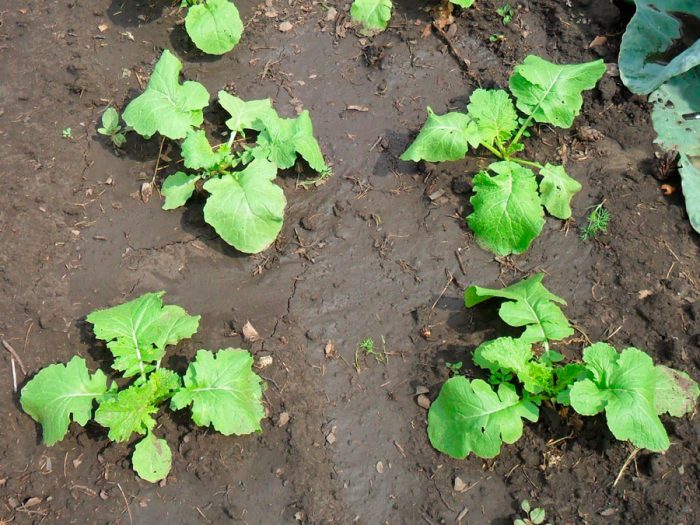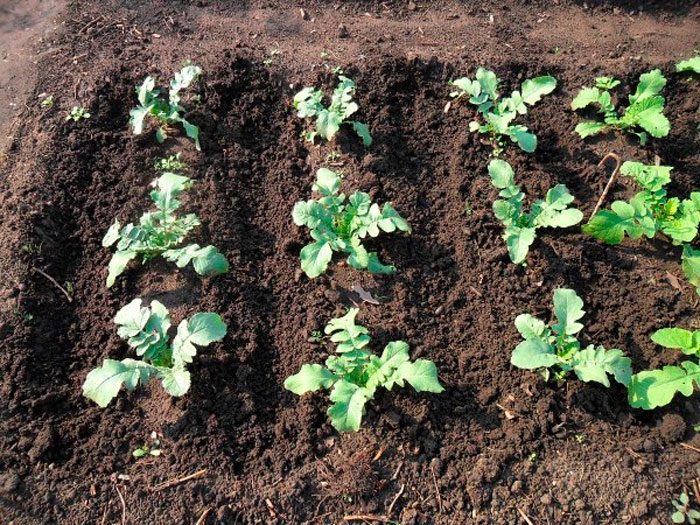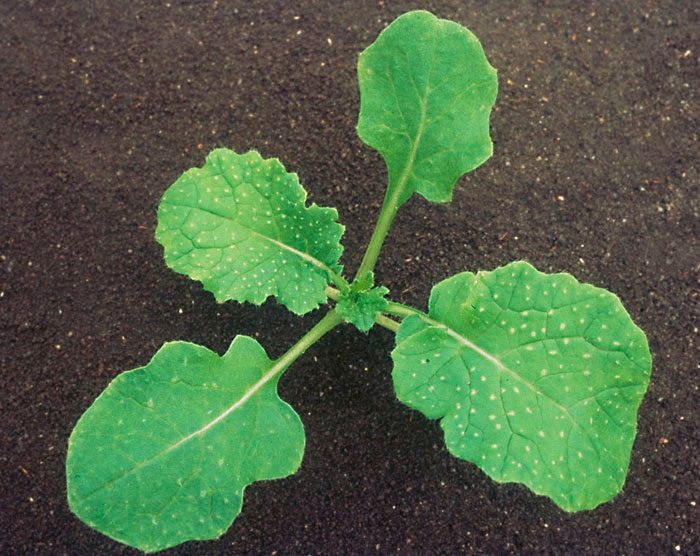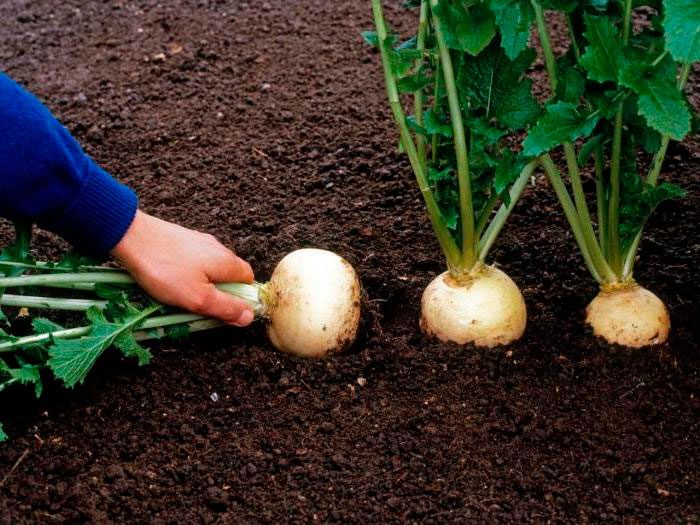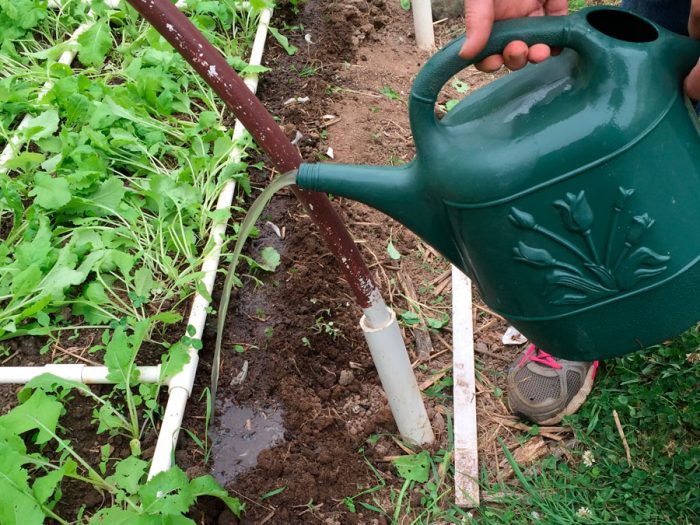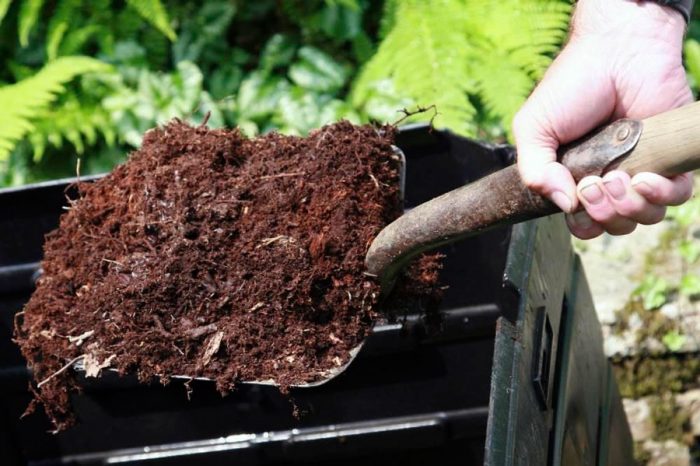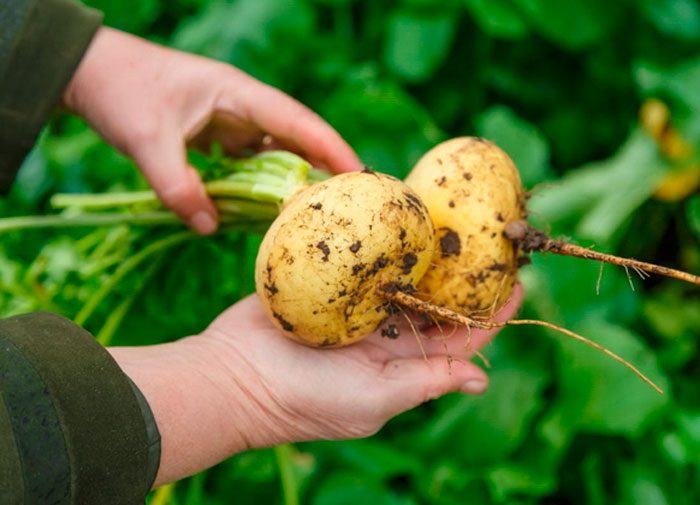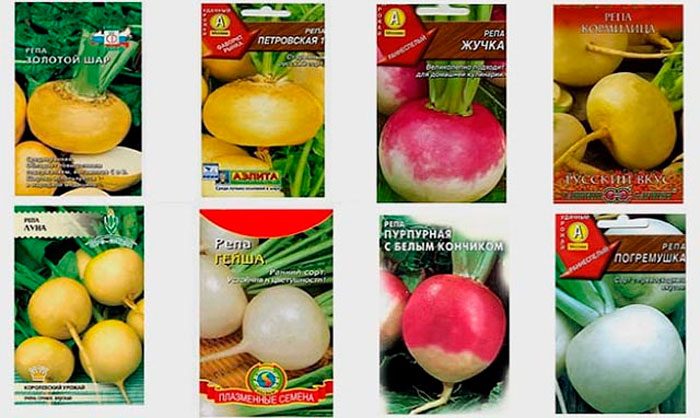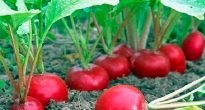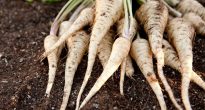The herbaceous plant turnip (Brassica rapa) can be an annual and perennial, it is a representative of the genus Cabbage of the Cabbage family or Cruciferous plants. This is a very ancient culture native to Western Asia. Turnips began to be cultivated about 4 thousand years ago. Such a vegetable in Ancient Greece and in Ancient Egypt was considered the main food of slaves and the poor, but in the Roman Empire all classes were prepared from it. On the territory of Russia, for many centuries, turnip was considered the most important food product, even in the most ancient chronicles there is a mention of such a culture. It was only in the 18th century that the turnip was supplanted by the potatoes imported from America.
Turnip is a valuable vegetable crop that has powerful medicinal properties. Such a root vegetable is used for baking, cooking, stuffing, and it is also added to salads. It has anti-inflammatory, analgesic, antimicrobial, diuretic and wound healing effects. And turnip helps to improve appetite, accelerate digestion and increase intestinal motility.
Content
Brief description of cultivation
- Sowing... Sowing turnip seeds in open soil for use in the summer is carried out immediately after the snow cover melts, and for winter storage - in July or in the first days of August. This culture can be sown before winter, do this shortly before the onset of stable frosts. Turnip seedlings are sown in mid-March, while seedlings are planted in open ground from mid to late May.
- Illumination... A suitable area should be well lit.
- Priming... Turnip grows well in clay light neutral soil.
- Watering... Watering turnips should be abundant and systematic. For 1 square meter of the garden, 0.5–1 buckets of water are taken. On average, you need to water turnips 1 or 2 times in 7 days, and do this in the early morning or in the evening after the sun sets.
- Fertilizer... During the growing season, such a crop is fed 1 or 2 times, for this, organic fertilizers or a mineral complex are used. Turnip responds best to feeding with wood ash.
- Reproduction... Seed method.
- Harmful insects... Cruciferous fleas and bugs, cabbage flies, cabbage moth, cabbage aphid, cabbage scoop, cabbage and turnip whiteweed, cabbage stem weevil, or secretive proboscis.
- Diseases... Carinae, phoma, mucous and vascular bacterioses, black leg and gray rot.
Turnip features
The turnip has a root, which is a fleshy thickened root vegetable. The tall stem is highly leafy. Green basal harsh-haired leaf plates have long petioles and a lyre-pinnately incised shape. Stem sessile leaf plates are ovoid, they are slightly pubescent or bare, as well as entire or toothed. During the first year of growth, only the edible root vegetable and the root leaf rosette develop. And in the second year of growth, a leafy stem grows at the root, on which a corymbose inflorescence is formed, it later transforms into a racemose. The petals of the flowers are dull yellowish or golden yellow. The fruit is an erect, short, knotty pod; brown-red seeds ripen in it, which have the shape of an irregular ball.
All varieties of turnips are divided into feed and table varieties. Forage varieties are called turnips. Turnip is considered a relative of the following vegetable crops: white cabbage, kohlrabi, Brussels sprouts, red cabbage, cauliflower, broccoli, Chinese cabbage, radish, radish, etc.
Growing turnips from seeds
Sowing
Sowing turnip seeds for seedlings is carried out 6–8 weeks before planting in open soil. Before starting sowing, the seed should be sorted out, and all injured, hollow and deformed seeds should be selected. Then it must be immersed in a solution of salt (5%), for its preparation it is necessary to combine 100 milligrams of water at room temperature and 5 grams of salt. The seed must be thoroughly mixed to remove air bubbles from its surface. Bad seeds will float, and suitable seeds will sink to the bottom.
After that, you need to disinfect the seeds, since 80 percent of the diseases are transmitted through the seed. It is best to warm them well, for this they use hot water. The seed is poured into a cloth bag, which is placed in very warm water (from 52 to 54 degrees) for a third of an hour, then it is immediately immersed in very cold water for 2-3 minutes. Also, the seeds can be disinfected in a solution of potassium permanganate (6.38 grams of the substance are taken per 100 milligrams of water at room temperature), they are immersed for a third of an hour.
Well-washed seed should be placed in water for swelling for several days, while changing the liquid 2 times a day. It is recommended to sow the seeds quite thickly, however, experts advise using peat tablets for this. To begin with, the tablets should be soaked in water for swelling, then 2 or 3 seeds are placed in each of them. The tablets are removed under a transparent dome and transferred to a well-lit place, which is protected from direct sunlight. As soon as the seedlings appear, the shelter must be removed.
Growing turnip seedlings
High humidity is observed under the hood, which is excellent for turnip seedlings. Seedlings are transferred to a cool place (from 5 to 15 degrees), in this regard, it is recommended to keep them on an unheated veranda or a glazed loggia. After opening the cotyledons in the plants, they should be thinned out using scissors, for this weak seedlings are cut at the level of the substrate surface, thanks to which they will not be able to take away nutrients from the stronger plants. Provide turnip seedlings with timely watering, feeding and loosening the surface of the substrate, which must be done very carefully.
Seedlings begin to harden half a month before planting in open soil.To do this, it is transferred every day to the street for a while, while it is necessary to increase the duration of the session gradually. After the seedlings are able to stay in the fresh air around the clock, they can be planted in the garden.
Picking
A pick for turnip seedlings is not recommended, since this culture reacts extremely negatively to transplantation. In this regard, it is recommended to use peat tablets for sowing, when the seedlings grow and get stronger, they are transplanted together with them into open soil, while maintaining a distance between them of at least 0.3 meters.
Planting turnips in open ground
What time to plant
Turnips can be grown through seedlings, but sowing directly into open soil is more popular with gardeners. Many gardeners are interested in what time to sow turnips in mid-latitudes? The time of sowing such a crop in open soil is influenced by the climatic characteristics of the region, as well as the purpose of its cultivation. For example, in the Moscow region, for summer use, turnips are sown in the last days of April, either in early May, or in the first days of June. If turnips are sown from the last days of June to mid-July, then it can be used both for cooking various dishes and for winter storage. In order for turnips to be obtained 15–20 days earlier than usual in spring, they use podwinter sowing. Seedlings appear already at a temperature of 2 to 5 degrees, but if the air warms up to 18 degrees and higher, then the seedlings may appear after only three days.
Suitable soil
A neutral light clay soil is ideal for growing such a crop. In this regard, acidic soil must be limed, otherwise the keeping quality of root crops will deteriorate significantly.
Before you start planting, you need to carefully prepare the site. Regardless of the time when sowing is planned, the preparation of the site must be done in the autumn. Tomatoes, potatoes, beans and cucumbers are good precursors for this plant. And after crops such as watercress, daikon, horseradish, any type of cabbage, radish, radish and turnip, it is impossible to grow turnips, since all these plants have the same pests and diseases. The site must be deeply dug, while 2 to 3 kilograms of compost or humus should be added to the soil (fresh manure cannot be used), 10–15 grams of phosphate and nitrogen fertilizers, as well as 15–20 grams of potash per 1 square meter plot.
Open ground planting rules
The prepared seed must be sown with two-line belts, while the distance between the lines should be about 20 centimeters. Immediately before sowing, the soil on the site is well loosened, and then it is rolled. Only then in the garden can you make grooves with a depth of 10 to 20 millimeters. The seeding density of seeds should be approximately 2 seeds per 10 millimeters. Fill the furrows carefully and water the crops.
Winter sowing
Sowing turnips before winter is carried out shortly before stable frosts begin. During the winter time, the seed will undergo natural stratification, and with the onset of spring, friendly shoots will appear on the garden bed. When sowing in winter, it is necessary to bury the seeds in the soil a little deeper than when sowing seeds in summer or spring. For filling the grooves, it is necessary to use sand or peat prepared in advance. It is recommended to install landmarks along the edges of the garden so that in spring you can easily find the area with crops. After the snow falls, they need to cover the crops, while trying to keep the layer even.
Turnip care
Growing a turnip on your site is very simple. After the appearance of seedlings, it is necessary to thin them out, while pulling out all weak plants.Then the surface of the site must be covered with a layer of wood ash, this will protect the turnip from cruciferous fleas.
Near the garden bed where the turnip is grown, experts advise growing peas or beans. When the site is covered with ash, it should be covered with a layer of mulch (straw or hay), this will reduce the amount of loosening of the soil surface in the garden bed. But despite the mulch, the site will still need to be systematically loosened and weeded. When the first thinning is completed, a second is carried out after half a month.
How to water properly
Such a culture is moisture-loving, in this regard, it must be watered systematically and abundantly, especially during a prolonged drought. On average, it is watered 1 or 2 times every 7 days. The amount of water taken per 1 square meter of the plot directly depends on the stage of development of the turnip, as well as on the weather conditions, and it varies from 5 to 10 liters of water. If the plants do not have enough water, then the roots will be rough and tough, and the pulp will acquire a bitter taste.
During seed germination, the culture needs timely watering most of all, as well as during the formation of true leaf plates and at the stage of active growth of root crops. After the roots reach the required volume, the amount of water used for irrigation must be reduced, otherwise they may begin to crack.
It is recommended to water turnips early in the morning or in the evening after the sun goes down. Cold water cannot be used for irrigation. It is recommended to install a volumetric container on the site in which tap water can settle well and heat up in the sun. For watering young bushes, use a watering can with a fine sieve, adult plants must be watered with a hose.
Turnip feeding
During the growing season, plants should be fed 1 or 2 times. To do this, you can use a mineral complex, or you can feed it only with organic fertilizers. Most gardeners are sure that turnips respond best to feeding with wood ash. Therefore, during the preparation of the bed under the turnip, a fire is kindled on it. The remaining charred logs should be scattered over the site, after which they dig it with them.
After the first true leaf plates begin to appear in the plants, it is recommended to feed them with herbal organic fertilizer.
Diseases and pests
All representatives of the Cabbage family have the same diseases and harmful insects, and therefore it is highly undesirable to grow them next to or not far from each other. Most often, turnips are affected by such harmful insects as: cruciferous fleas and bedbugs, cabbage flies, cabbage moth, cabbage aphid, cabbage scoop, cabbage and turnip whiteweed, cabbage stem weevil, or secretive beetle. This plant can infect keels, phomoses, mucous and vascular bacterioses, black leg and gray rot.
Turnip processing
To protect this plant from harmful insects and diseases, it is imperative to adhere to the rules of crop rotation. Also, when planting and growing such a crop, one must not forget about the agrotechnical rules of turnips:
- sowing material needs mandatory pre-sowing preparation, as well as dressing;
- seedlings must be thinned out;
- weeding on time;
- in the autumn, the site must be cleaned of plant residues that should be burned;
- the garden bed needs a good digging after harvest.
If, nevertheless, the bushes are affected by a fungal disease, then the diseased plants should be dug up as soon as possible, and folk remedies should be used to process the remaining turnip. However, if the bushes are very sick, then the area should be sprayed with fungicidal preparations, for example: Topsin, Fundazol or other means of similar action.To destroy harmful insects, it is also recommended to use folk remedies, for example, decoction of potato or tomato tops. For its preparation, the tops are combined with water and boiled for 30 minutes, after which the strained broth must be diluted with water in a ratio of 1: 3. Then in 1 bucket of water it is necessary to dissolve 40 grams of soap crushed on a grater. This remedy will help you get rid of various pests, including whites, flies, scoops, and moths. If the turnip is very badly affected by pests, then the bushes will need to be sprayed with insecticidal preparations, for example: Aktellik, Karbofos, Metaphos, etc.
Turnip harvesting and storage
If everything is done correctly when planting and growing turnips, this will allow you to get a rich harvest of this root crop. It was already mentioned above that for storage in the winter, you can use only that turnip that was sown from the end of June to the last days of July. In Russia, there was a tradition of harvesting at the Exaltation, namely on September 27. If you delay the harvesting of turnips for a long time, the root crop will outgrow and lose its taste.
Harvesting should be started on a dry, sunny day, while you should try not to injure the turnip, since damaged roots most often rot during storage. The tops of the dug turnips should be cut off, while the length of the remaining petioles should be about 10–20 mm, cut off all the woody roots. Remove any residual soil from the root vegetables and spread them out in a shaded area to dry out. After sorting, for the first time, they are placed in storage under a layer of straw, which is mixed with the soil, the layer thickness should be about 10 centimeters. Then the turnips are placed in a basement or cellar, where they should be stored at a temperature of 0-3 degrees. Before placing them in the cellar, turnips must be folded into boxes filled with peat chips or dry sand, while they must be positioned so that the turnips do not touch each other. If done correctly, the late turnip will retain its freshness for several months. If there are few root crops, then they can be wrapped in plastic wrap and stored on a refrigerator shelf. A turnip wrapped in foil can be stored on the balcony. Root vegetables on the balcony and in refrigerators can keep their freshness for about one month. At room temperature, turnip is stored for about a half moon, then its pulp acquires a bitter taste. Best of all, root crops retain their freshness during storage, reaching at least 50 mm in diameter.
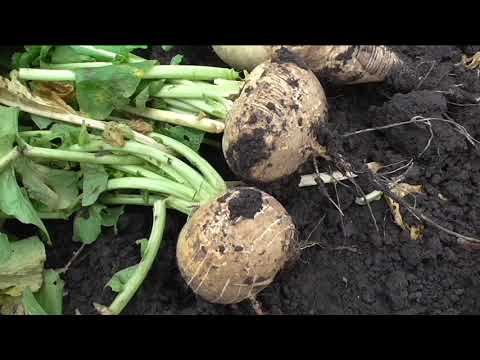

Watch this video on YouTube
Types and varieties of turnip
All varieties of turnips are divided into feed and table varieties for their intended purpose. Moreover, among the table varieties there is a group of salad varieties. Their peculiarity is that in table varieties, only root crops are used for food, and in salad varieties, roots and foliage are used. Also, all varieties are divided into:
- early ripening - ripen in 40-60 days;
- average ripening period - ripen in 60–90 days;
- late ripening - ripen in 90 days and longer.
All varieties are also divided according to taste. The most popular varieties are:
- Petrovskaya-1... This mid-early variety is distinguished by good keeping quality, unpretentiousness and productivity. Juicy yellow roots have a rounded slightly flattened shape and a sweetish taste.
- White Night... The Czech medium-ripening variety is fruitful. Root crops weigh about 0.5 kg, they, like the juicy pulp, are colored white.
- Geisha... An early variety of Japanese salad turnip kokabu is distinguished by frost resistance and productivity. Round-shaped white roots weigh about 200 grams, they do not have a sharp-bitter taste, which is characteristic of this plant, and delicate leaf plates are also used for preparing salads.
- Snow Maiden... An early high-yielding variety of lettuce turnip has small rounded white roots, weighing about 60 grams, they are covered with thin skin, and their pulp is tender and juicy. The foliage rich in vitamins is used to make salads.
- May yellow green-headed... Such an early ripening variety is not suitable for storage, its roots have a tender and juicy pulp.
- Sapphire... Juicy, smooth and tender leaf plates are most appreciated in such a salad turnip.
- Snow White... It is an early shade-loving and frost-resistant salad variety. The mass of rounded root crops is about 80 grams, they are white, like their pulp, it is very tasty, juicy, dense and tender.
- Golden ball... The average ripening period is a consistently productive variety, characterized by frost resistance and unpretentiousness. The mass of yellow rounded root crops is about 150 grams, they are covered with a delicate smooth and thin skin, their flesh is juicy and dense.
- Early ripe purple... This variety is very popular. White roots have a rounded shape, they reach 8 to 12 centimeters in diameter, and their weight is 65–90 grams. Their top is colored purple, and the flesh is sweet, juicy and white in color.
The following varieties of turnips are also very popular with gardeners: Khrusta, Tokyo Cross, Pull-push, Pull-pull, Snowball, Snow Globe, Russian size, Russian fairy tale, Orbit, Presto, Rattle, Moon, White May, Little Red Riding Hood, Lyra, Flatbread, Nurse, Comet, Dunyasha, Burnt sugar, Dutch white, Gribovskaya, Dedka, Granddaughter, etc.


Watch this video on YouTube

